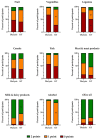Adherence to Mediterranean Diet in Individuals on Renal Replacement Therapy
- PMID: 36901049
- PMCID: PMC10002197
- DOI: 10.3390/ijerph20054040
Adherence to Mediterranean Diet in Individuals on Renal Replacement Therapy
Abstract
Patients on renal replacement therapy are typically subject to several dietary restrictions; however, this approach has been questioned in recent years, with some suggesting that the Mediterranean diet might be beneficial. Data on the adherence to this diet and factors that influence it are scarce. We conducted a web survey among individuals on renal replacement therapy (dialysis or kidney transplant, KT) using the MEDI-LITE questionnaire to assess adherence to the Mediterranean diet and dietary habits in this population. Adherence to the Mediterranean diet was generally low, and significantly lower among participants on dialysis versus KT recipients (19.4% vs. 44.7%, p < 0.001). Being on dialysis, adopting fluid restrictions, and having a basic level of education were predictors of low adherence to the Mediterranean diet. Consumption of foods typically included in the Mediterranean diet, including fruit, legumes, fish, and vegetables, was generally low, particularly among those on dialysis. There is a need for strategies to improve both the adherence to and the quality of the diet among individuals on renal replacement therapy. This should be a shared responsibility between registered dietitians, physicians, and the patient.
Keywords: Mediterranean diet; dialysis; kidney transplant.
Conflict of interest statement
The authors declare no conflict of interest.
Figures





References
-
- Ikizler T.A., Burrowes J.D., Byham-Gray L.D., Campbell K.L., Carrero J.J., Chan W., Fouque D., Friedman A.N., Ghaddar S., Goldstein-Fuchs D.J., et al. KDOQI Clinical Practice Guideline for Nutrition in CKD: 2020 Update. Am. J. Kidney Dis. 2020;76:S1–S107. doi: 10.1053/j.ajkd.2020.05.006. - DOI - PubMed
Publication types
MeSH terms
LinkOut - more resources
Full Text Sources

